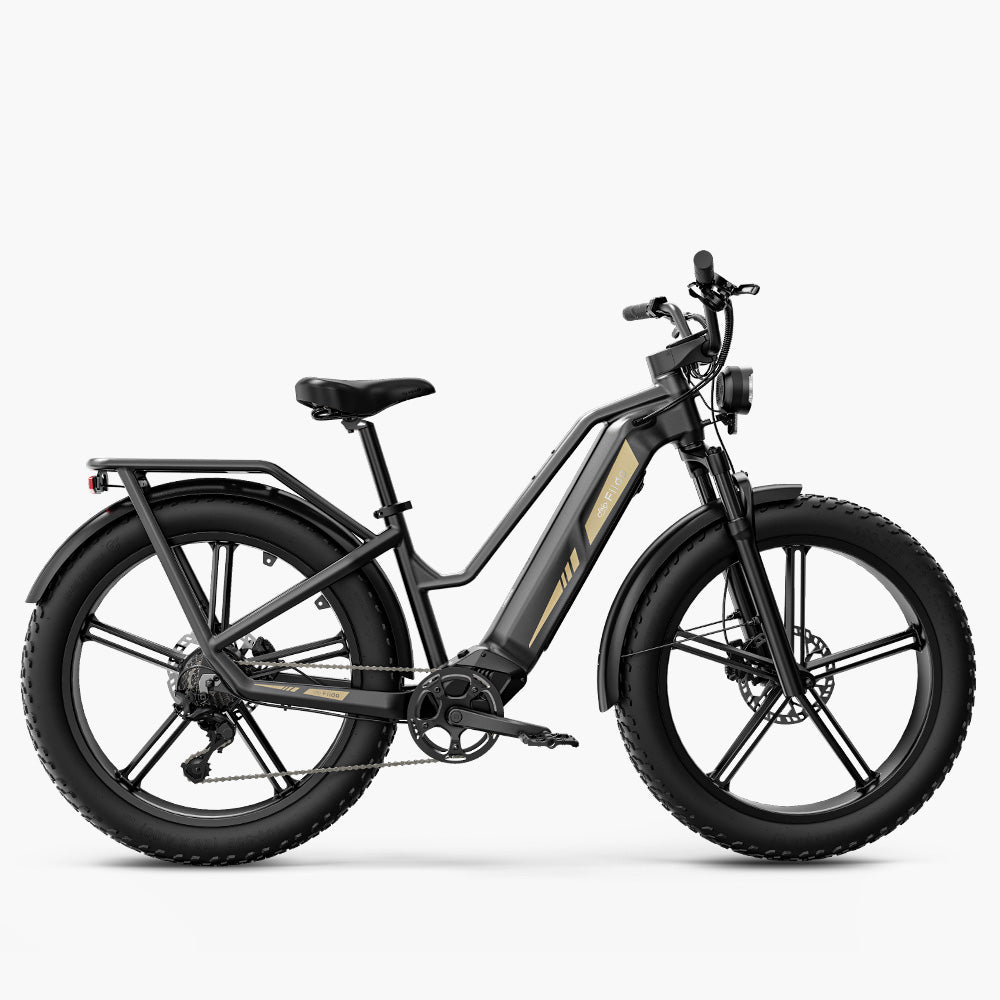The controller of an electric bike is like the human brain, coordinating communication between various components. This coordination is crucial for all types of electric bikes, including fat tire electric bikes, which require careful management to handle their size and weight. When you accelerate or brake, the controller receives these commands and adjusts the motor's power output, ensuring a smooth and comfortable ride. It is key to the electric bike's operation, directly influencing your riding experience and efficiency.
Common Issues
Although controllers are designed to be robust, they can still encounter common problems over time:
1. Loss of Power
- Symptoms: The electric bike cannot accelerate.
- Causes: This may be due to the controller failing to transmit power to the motor, internal circuit faults, or insufficient battery charge.
- Impact: Loss of power directly affects riding comfort and safety.
2. Flickering Indicator Lights
- Symptoms: The controller indicator light frequently flickers.
- Causes: This typically indicates an internal fault, such as overload or short circuit.
- Impact: It may lead to instability in the electric bike, or even complete failure.
3. Overheating
- Symptoms: The controller surface becomes hot and may emit a strange smell.
- Causes: Continuous high load, poor heat dissipation, or high ambient temperatures can cause this issue.
- Impact: Overheating can affect performance and potentially cause permanent damage.
4. Incorrect Speed Display
- Symptoms: The speedometer displays inaccurate speed information.
- Causes: This may be due to a connection issue between the speed sensor and the controller or a software fault within the controller.
- Impact: Incorrect speed readings can increase the risk of accidents for the rider.
How to Repair the Controller
Tools Needed:
- Screwdrivers (both Phillips and flathead)
- Multimeter (to measure voltage and current)
- Cable cutters
- Electrical tape
- Disassembly tools (like a pry tool, if necessary)
Here are some basic repair steps to help you diagnose the problem and fix it:
-
Check Connections Ensure all connections between the battery and the controller are secure. Check each cable plug for looseness or corrosion. Always disconnect the power before inspection to avoid electric shock.
-
Reset the Controller Some controllers have a reset button. Pressing it may resolve temporary software issues; it's advisable to record any fault information before resetting.
-
Detect Fault Codes If the controller has a fault indication feature, refer to the user manual for the fault code list and observe the flashing patterns of the indicator light to identify the specific problem.
-
Replace Components If you find that certain components inside the controller are damaged, they need to be replaced. Refer to instructional videos for guidance on replacing the controller, ensuring you use original parts for compatibility.

How to Maintain the Controller and Prevent Future Issues
Regular maintenance of your electric bike's controller is essential for optimal performance. Here are some key tips:
-
Keep Connections Clean
Regularly inspect and clean the connectors between the battery, controller, and motor. Ensure all connections are secure to avoid intermittent issues. -
Avoid Overloading
Be mindful of weight limits to prevent straining the controller and causing overheating. -
Ensure Proper Cooling
Allow for adequate ventilation around the controller. Avoid blocking air vents and let the controller cool down if it overheats. -
Check for Software Updates
Regularly look for firmware updates from the manufacturer to fix bugs and enhance performance. -
Conduct Routine Inspections
Periodically check for signs of wear, such as frayed wires or loose connections, and address any issues promptly. -
Store Properly
Keep your electric bike in a dry, temperature-controlled environment to protect the controller from extreme conditions.
Repair Considerations
When attempting to repair the controller, keep the following in mind:
- Seek Professional Help: It is recommended to consult Fiido's official service or authorized repair shops for repairs. Fiido offers comprehensive after-sales support to ensure users receive timely assistance during use. Contact Fiido's support email at after-sales: support@fiido.com; attempting self-repair may cause further damage.
- Understand Warranty Policies: For faults within the warranty period, refer to Fiido warranty policy details via the provided link, and it's best to contact after-sales service for resolution.
Repair Cases
- Loss of Power: A user experienced a sudden loss of power while riding, only to find that a loose connection was the issue. A simple fix restored normal operation.
- Overheating Problem: Another user had an overheating controller, which was discovered to be due to prolonged exposure to high temperatures. Replacing the controller helped avoid future issues.
Advantages of Fiido Electric Bikes
Fiido electric bikes are widely praised for their exceptional durability and high performance. The design prioritizes not only riding comfort and efficiency but also long-lasting use, allowing users to enjoy worry-free riding for years without frequent repairs—all thanks to the core controller.
Key Role of the High-Performance Controller
The controller acts as the "brain" of the electric bike, regulating motor functions and controlling battery output, ensuring smooth system operation. Fiido's controllers utilize advanced technology to efficiently manage current and voltage, optimizing motor performance and reducing failure rates. This efficiency not only ensures stable riding performance but also significantly enhances the overall durability of the bicycle by minimizing repair issues.
Durable Design
In addition to a high-performance controller, Fiido carefully selects materials, utilizing high-strength aluminum alloy and lightweight carbon fiber. These choices allow Fiido electric bikes to excel in challenging road conditions and adverse weather, ensuring they withstand the wear and tear of daily use.
Efficient Battery
Fiido's batteries are optimized to provide long-lasting range. For example, the Fiido T2 fat tire electric bike boasts a range of over 69 kilometers, making it suitable for daily commutes and short trips.
Fiido T2 Longtail Cargo E-bike
Multifunctional, family-friendly cargo ebike with endless possibilities.
Comfort and Safety
Fiido electric bikes also excel in comfort. Take the Fiido Titan off-road electric bike, for instance—it’s an all-terrain electric bike equipped with a robust suspension system that effectively absorbs road vibrations, offering a smoother riding experience. Additionally, Titan’s powerful braking system and wide tire design ensure safety, particularly on high-speed or rugged terrains.
Fiido Titan Robust Cargo Electric Bike
A powerhouse with a 248-mile range and 4-piston brakes, ideal for hunting and fishing trips.
Conclusion
The controller of an electric bike is akin to the "brain" of the whole system, managing the motor and battery to provide a smooth and efficient riding experience! While you may encounter occasional minor issues, timely maintenance and repair can keep your beloved bike in service for years.
Fiido electric bikes, including their off-road electric bikes and fat tire electric bikes, are praised for their super-efficient controllers, high-quality materials, and comfortable designs. These bikes make for the perfect riding companions, ideal for daily commutes and leisurely rides alike. Mastering the functionality and maintenance of the controller will enhance your riding enjoyment even further!















